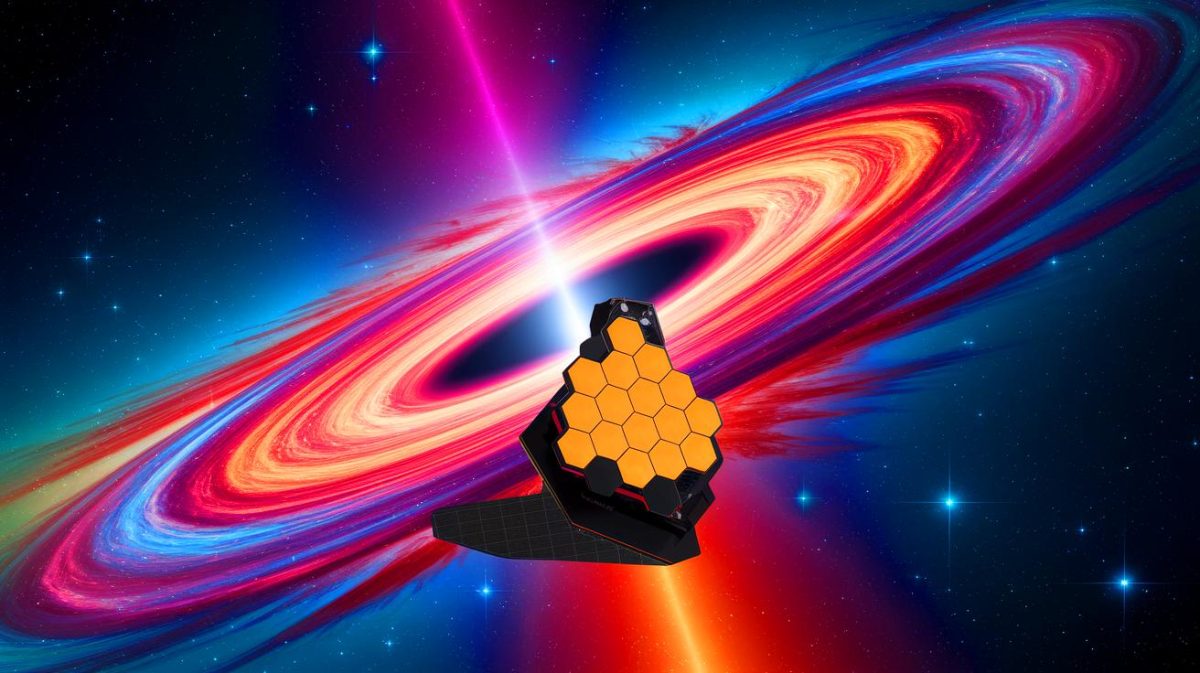| IN A NUTSHELL |
|
The James Webb Space Telescope (JWST), a marvel of modern technology, has recently turned its keen eye toward Sagittarius A*, the supermassive black hole nestled at the heart of our galaxy. The observations reveal an environment of unexpected turbulence, akin to a chaotic light show. These groundbreaking insights are reshaping our understanding of these cosmic giants and their surroundings, offering a glimpse into the dynamic and often unpredictable nature of black holes.
A Frenzied Dance of Light
Since its commissioning, the James Webb Space Telescope has continually pushed the boundaries of our understanding of the universe. Its latest achievement? An unprecedented dive into the heart of the Milky Way, approximately 26,000 light-years from Earth, to observe the supermassive black hole known as Sagittarius A* (Sgr A*). The images transmitted by the telescope, with unmatched precision, reveal a fascinating spectacle: a continuous ballet of lights and flashes far removed from the static image one might expect from such a cosmic monster.
Three years ago, the Event Horizon Telescope provided us with the first direct image of Sgr A*. Now, the JWST offers a window into its immediate environment, unveiling a complex and surprising dynamic. The telescope’s NIRCam (Near-Infrared Camera) was utilized for 48 hours, spread over several periods in 2023 and 2024, to scrutinize the accretion disk of Sgr A*. This spiral of gas and dust, heated to millions of degrees, swirls around the black hole before being engulfed.
An Unpredictable Cosmic Beacon
The data collected by the JWST paints a striking picture. Far from being a dark and silent abyss, the environment of Sgr A* is the stage for a veritable fireworks display. Scientists, led by Farhad Yusef-Zadeh from Northwestern University, have observed a constant flickering punctuated by intense and seemingly random luminous eruptions.
These light emissions occur on two levels. On one hand, there is a faint, continuous component likely due to internal turbulence within the accretion disk. On the other hand, brief yet extremely bright eruptions are associated with phenomena of magnetic reconnection. These eruptions occur when magnetic fields collide, releasing phenomenal amounts of energy akin to solar flares but on a much grander scale. “We observed constantly evolving brightness,” explains Farhad Yusef-Zadeh. “Suddenly, a burst of brightness appears, then calms, without following a precise pattern.” This apparently chaotic nature suggests that Sgr A*’s accretion disk is in perpetual renewal, generating between five and six major eruptions daily, in addition to multiple more discrete flares.
The Dual Vision of the JWST
One of the major strengths of the JWST is its ability to observe two infrared wavelengths (2.1 and 4.8 micrometers) simultaneously. This “dual vision” allowed researchers to compare the luminosity variations of eruptions based on wavelength.
The results revealed a temporal lag: events observed at the shorter wavelength changed luminosity slightly before those observed at the longer wavelength. “This is the first time we’ve observed such a lag between these wavelengths,” notes Yusef-Zadeh. This lag, ranging from 3 to 40 seconds, suggests that energetic particles lose energy as they cool down, a process known as synchrotron cooling.
A New Perspective on Black Holes
These JWST observations mark a significant advancement in our understanding of supermassive black holes. They reveal the complexity and unsuspected dynamics of their immediate environment, challenging existing theoretical models.
Researchers now plan to conduct continuous observations of Sgr A* over a 24-hour period to determine if the eruptions follow repetitive patterns or are genuinely random. Each flash, each variation in luminosity captured by the JWST brings us a step closer to understanding the extreme physical phenomena occurring near the event horizon, the invisible boundary beyond which nothing, not even light, can escape the black hole’s gravitational pull.
Beyond Sgr A*: Implications for Fundamental Physics
The discoveries of the JWST extend beyond a deeper understanding of Sgr A*. They also open exciting prospects for fundamental physics. By studying the behavior of matter and spacetime under extreme gravitational conditions, scientists hope to test the limits of Einstein’s general relativity and perhaps glimpse new physical laws.
The study of Sgr A* is far from over. The JWST, with its unparalleled sensitivity and resolution, will undoubtedly continue to surprise us and reveal the best-kept secrets of our galaxy. The chaotic light show observed around Sgr A* is just the prelude to new discoveries, which may well revolutionize our understanding of the universe.
This study, published in The Astrophysical Journal Letters, demonstrates the crucial importance of next-generation telescopes like the JWST for astronomy. By offering us an unprecedented view of distant and enigmatic cosmic objects, these instruments push the boundaries of our knowledge and open new avenues for research. As the JWST continues to illuminate our path, what new cosmic mysteries will it help us unravel?
Did you like it? 4.5/5 (21)








Wow, the universe is full of surprises! Thanks, JWST! 🌌
Is it possible for these eruptions to affect Earth in any way? 🤔
Amazing work by the James Webb team! Keep the discoveries coming. 🚀
So, are we basically watching a cosmic disco at the center of our galaxy? 🕺
How do they even measure something that far away? Science is wild!
I’m skeptical about these findings. How can we be sure they’re accurate?
Can anyone explain what “magnetic reconnection” is in simpler terms?
Another day, another mind-blowing discovery by the JWST. Hats off!
It’s fascinating how much we still don’t know about black holes. 🤯
Does this mean we need to update all our black hole sci-fi plots? 😅